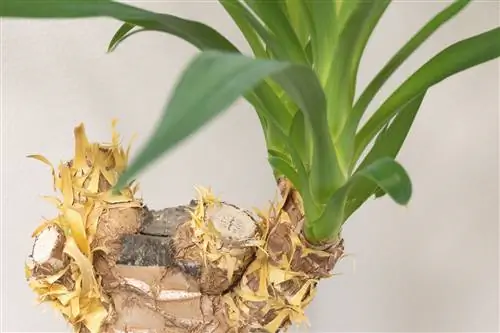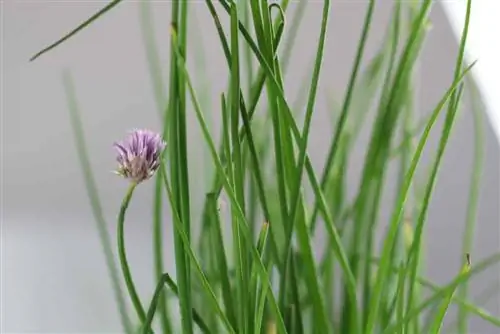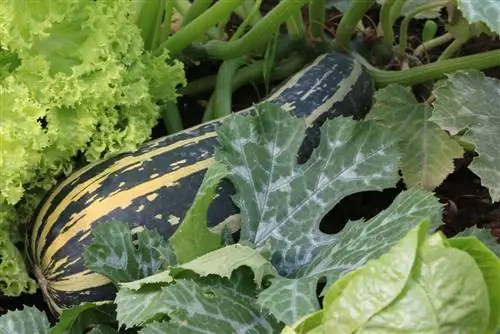- Author admin [email protected].
- Public 2023-12-17 03:39.
- Last modified 2025-01-24 12:45.
The palm-like appearance of the yucca is deceptive because the plant belongs to the species-rich agave family. Many representatives of the plant genus are just as common in domestic living rooms and gardens as they are in public parks. Palm lilies are particularly popular with hobby gardeners as they exude a Mediterranean flair. Due to the immense growth height, it is often unavoidable that the plant parts of the Yucca palm have to be shortened. There is very little to take into account with this measure, because the agave plants are extremely robust and resilient.
Uncomplicated houseplants
Yucca, also known as palm lily, is a species-rich genus from the agave family (Agavaceae). Around 30 different varieties of stemless and stem-forming Yucca palms are known worldwide. The numerous species differ immensely in their external appearance. In addition to the classic, palm-like appearance, there are also examples that are reminiscent of a cactus. The robust plants are also suitable for beginners and are considered almost indestructible. The tree-like agave plants in particular are very regenerative and can easily cope with many care mistakes. In summer you can conjure up a tropical flair in the garden or on the sunny terrace with the palm-like plants.
Keeping the plants he althy and growing is anything but difficult. Provided that you give the potted plants a bright location and a regular supply of water and nutrients during the main growing season. How you overwinter your yucca palm and when it is time to move it from the outdoors to its winter quarters depends on the type of palm lily. Some representatives of the Yucca can even be cultivated in the garden all year round.
First Aid
A top-heavy trunk or a careless collision with the palm lily is usually enough to break off the fine side shoots. However, you can easily save torn plant parts. First, look at the wound edges of the mother plant and the broken shoot. You should smooth out any frayed areas with a sharp knife and seal them with wax on the large plant. Remove all dead or wilted leaves from the shoot and let the plant piece dry for 24 hours. The further steps are similar to growing cuttings: Use a tall container with lean substrate into which you place the broken piece of plant. The soil must be kept evenly moist. There should be no waterlogging. Place drainage at the bottom of the bucket or pay attention to the correct amount of watering. You can tell whether and when root formation was successful by the formation of new leaves.
To prevent further damage to the mother plant, it should be moved to a larger pot. Large palm lilies often shift their center of gravity upwards due to their lush leaves and trunk height. If you don't want to cut down the plant, you can weigh down the inside of the container with some larger stones.
Cut Yucca palms correctly
A growth height of 3 meters or more is not unusual for Yucca. Of course, only if you optimally meet the plant’s care and location requirements. However, you should take countermeasures at the latest when the plant collides with the ceiling. Some hobby gardeners resort to rehoming palm lilies that have grown too large through local classified ads. But you don't have to part with the houseplant that you have cared for and cared for for years. Yucca palms are easy to shorten. Yucca palms that have grown too large can be cut back to any height. Even a bare trunk will sprout again within a few weeks in a partially shaded location. In order not to weaken the plant unnecessarily, you should carry out this measure in spring. Prepare the following material:
- Pruning saw
- Felt pen
- lean substrate
- Planter
The saw should be fine-toothed so that you don't cause frayed cutting edges on the yucca. Theoretically, it is enough if you shorten the large plant by a good bit. Whether you only leave 30 cm of the trunk or just shorten the crown of the palm lily is completely up to you. Take advantage of the opportunity to propagate the plant at the same time.
Just a piece of trunk about 10 cm long is enough to grow a new plant from. You should use the felt-tip pen to mark the top and bottom immediately after cutting. It is important to make sure to insert the plant piece into the planter on the correct side. Because the roots only form on the lower part of the trunk. When left unrooted, the Yucca section is unable to absorb nutrients. If you use a humus-rich substrate, there is also the risk that the freshly sprouted roots will suffer “burns” due to the excess supply of minerals. As with all cuttings and seeds, you should use poor soil. Place the stem pieces on the substrate and keep the soil moderately moist. To speed up root formation, you can also temporarily increase the humidity. Water firmly and wrap the planter with clear, perforated film. This is removed for a few hours each day to promote air circulation and prevent potential mold formation. As soon as new shoots appear, you can move the young yucca palm into humus-rich soil and slowly accustom it to a sunny location.
Tip:
Yucca palms sprout through “sleeping eyes” on the side of the trunk. To prevent infections, you should coat larger cut surfaces with tree or candle wax.
By the way, it is a misconception that regular shortening of the roots permanently inhibits the growth of the plant itself. Although you can use this measure to regulate the height growth for a certain period of time, the yucca often grows wider. The diameter of the trunk increases.
Propagate successfully
A yucca palm does not necessarily have to be cut for reasons of space. If you just want to attract an offshoot, the tribe doesn't necessarily have to believe in it. Instead of a radical cut, it is sufficient to cut off the crown. Alternatively, you can also use an existing secondary shoot - often called a kindel. You should use a sharp kitchen knife to cut it off. Disinfect before and after work to avoid potential spread of pathogens and pests.
- Cut off the side or top shoot close to the trunk.
- Coat the wound on the mother plant with candle or tree wax.
- Free the lower cut edge of the cuttings from leaves.
- The location for root formation should be bright but not full sun.
- The ambient temperature should not fall below 15 °C.
- Use lean substrate.
- Keep the soil moderately moist.
Instead of using potting soil, you can also let the cutting root in a glass of water. Replace the water weekly and plant the young yucca immediately once the roots have formed. The soil of the “mother plant” should also be kept evenly moist until the first new shoots appear. During this time you should also avoid excessive fertilization.
Conclusion of the editors
Due to their exotic appearance, robustness and undemanding nature, yucca palms are among the most popular houseplants. Some species can cope even with double-digit minus temperatures without any problems. There is no science to cutting or propagating yucca palms. Even hobby gardeners who don't have a green thumb can do this effortlessly. The only thing you need is a sharp knife or saw and some patience for root formation.
What you should know about cutting yucca in brief
Cutting tips
- The Yucca palm should ideally be pruned in spring.
- Then the plant has the best chance of surviving the strenuous procedure without major damage.
- If it is then temporarily placed on the terrace or balcony, growth can improve after pruning.
- The interfaces resulting from shortening should be treated with a wound closure preparation.
- The preparation also prevents the plant from drying out or even from stunting.
- In addition, it protects the Yucca palm from fungal infestation, which can occur quite quickly at the interfaces.
Care after cutting
- The yucca should only be watered regularly, but very cautiously, in the winter months.
- In the warm season it is sufficient to place the root balls in water that contains as much lime as possible.
- If there are no more air bubbles rising, the excess water can drip off in peace.
- The yucca palm can then be moved back into its pot.
- The plant should also be fertilized from time to time with a lime-rich substrate in order to maintain a long lifespan.
If you follow these tips, you won't have any problems with yellow leaves etc. on the Yucca palm. By pruning in spring, the plant can thrive even more magnificently and show very strong growth.






